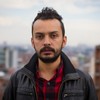Days after the No vote, Colombians in favor of peace took to the streets in protest. Their mobilization applied enough pressure to instigate new peace talks between FARC and the Colombian government. Photos via Raul Arboleda/AFP/Getty Images
Photos via Raul Arboleda/AFP/Getty Images
Humberto de la Calle (left), the head negotiator for the Colombian government, and FARC commanders Iván Márquez (center) and Pablo Catatumbo (right) announced on October 7, 2016, that they would hear proposals to amend the rejected peace accord. Photo via STR/AFP/Getty Images
